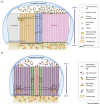Wnt and Hedgehog: Secretion of Lipid-Modified Morphogens
- PMID: 29132729
- PMCID: PMC6941938
- DOI: 10.1016/j.tcb.2017.10.003
Wnt and Hedgehog: Secretion of Lipid-Modified Morphogens
Abstract
Morphogens are signaling molecules produced by a localized source, specifying cell fate in a graded manner. The source secretes morphogens into the extracellular milieu to activate various target genes in an autocrine or paracrine manner. Here we describe various secreted forms of two canonical morphogens, the lipid-anchored Hedgehog (Hh) and Wnts, indicating the involvement of multiple carriers in the transport of these morphogens. These different extracellular secreted forms are likely to have distinct functions. Here we evaluate newly identified mechanisms that morphogens use to traverse the required distance to activate discrete paracrine signaling.
Keywords: Hh; Wg; Wnt; cancer; exosomes; lipoprotein; tissue patterning; vesicles.
Copyright © 2017 Elsevier Ltd. All rights reserved.
Figures




References
Publication types
MeSH terms
Substances
Grants and funding
LinkOut - more resources
Full Text Sources
Other Literature Sources
Molecular Biology Databases

